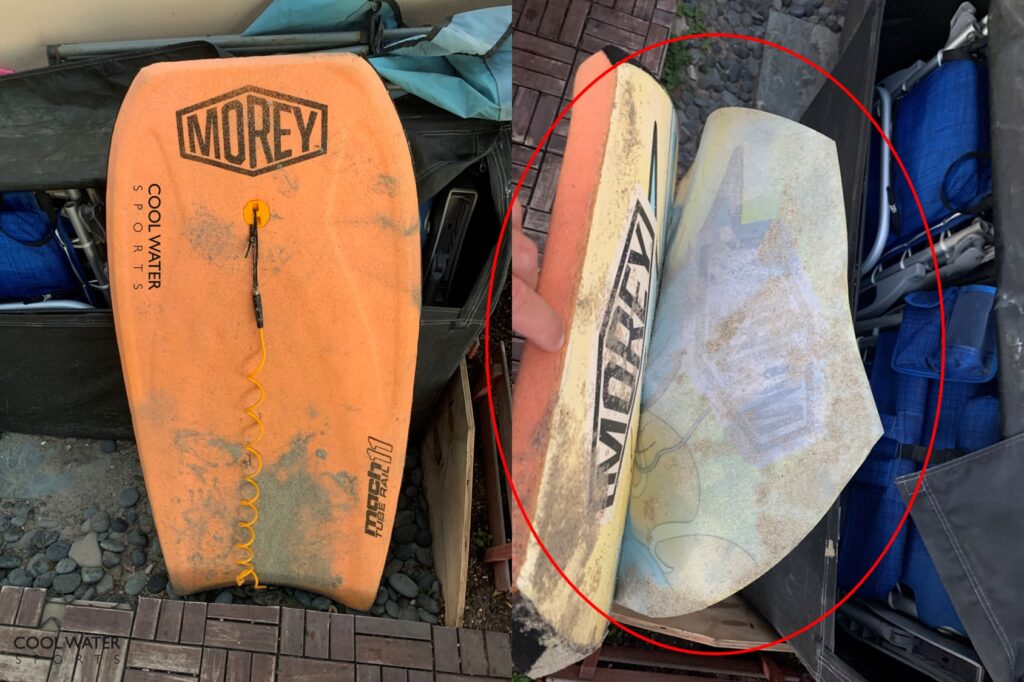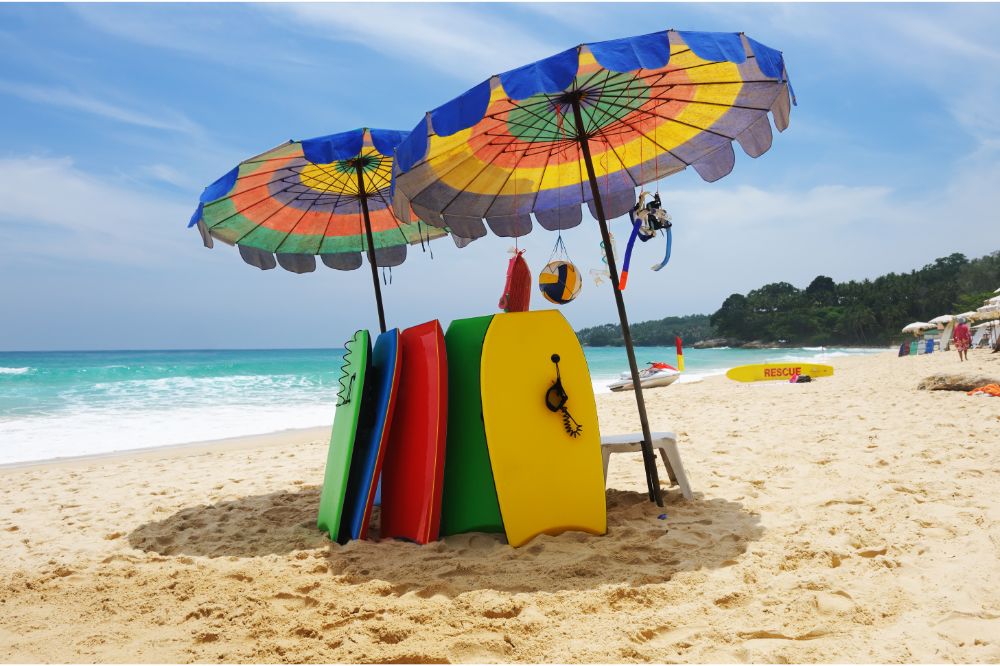Just like any other piece of sporting equipment, your bodyboard requires proper care and maintenance to ensure its longevity and performance. Achieving this doesn’t have to be a time-consuming or difficult process; by following some simple steps, you can keep your bodyboard in peak condition for many exciting sessions in the water.
Read on to discover how to care for, maintain, and repair your bodyboard effectively.

The Importance of Bodyboard Care
Taking care of your bodyboard is essential if you want it to last as long as possible. Proper care will help protect your board against potential damages, as well as maintain its performance and appearance. Your bodyboard will be exposed to harsh elements, such as sunlight, sand, and saltwater, which can cause wear and tear over time. By regularly maintaining and caring for your bodyboard, you’re not only prolonging its life but also ensuring that you have a reliable and enjoyable piece of equipment for all your wave-riding adventures.
The main reasons why you should take proper care of your bodyboard are:
Durability
Proper maintenance and care can significantly extend the life of your bodyboard, allowing you to get more use out of it over time. This can save you money in the long run by reducing the need to replace your board frequently.
Performance
A well-maintained bodyboard will perform better in the water, allowing you to ride waves more easily and with greater control. Neglecting maintenance can result in a decrease in performance, as the board may become warped, waterlogged, or damaged.
Safety
A poorly maintained bodyboard can pose safety risks to the rider and others in the water. Damage to the board can cause it to break or come apart while riding, potentially leading to injuries.
Hygiene
Proper cleaning and maintenance of your bodyboard can help prevent the growth of bacteria, mold, and mildew that can cause unpleasant odors and potential health risks.
So, let’s dive into the different steps and practices for maintaining and caring for your bodyboard.
How Regular Maintenance Can Prolong the Life of Your Bodyboard
The main reasons why it is worth it to clean your board after usage are:
It is a simple yet effective way to increase mainly the durability of the bodyboard, but also to keep up the performance of the board. Furthermore, it is more pleasant to ride on a hygienic board.
How cleaning helps with durability
Dirt, sand, and saltwater can accumulate on your bodyboard after use, and if left uncleaned, these elements can cause damage to the board over time. Regular cleaning can help remove these particles and prevent them from causing scratches, dings, or other types of damage to the board’s surface.
Especially remaining salt is an issue
Saltwater can be very corrosive or oxidating, respectively, to many materials, including the materials commonly used to make bodyboards. If saltwater is left on a bodyboard for an extended period of time, it can start to damage the board’s surface and its core.
One way that saltwater can damage a bodyboard is by causing oxidation of the board’s foam core. This can cause the foam to break down and lose its elasticity, which can reduce the board’s performance and lifespan. Over time, the board may become soft, brittle, or warped, making it difficult to ride and potentially unsafe.
Saltwater can also cause the glue and other materials used to construct the bodyboard to break down, which can lead to delamination or separation of the layers. Delamination occurs when the layers of the board start to separate, which can cause the board to lose its structural integrity and become unsafe to ride.
In addition to damaging the board itself, saltwater can also cause rust or corrosion on the metal components of the bodyboard, such as the leash plug or the screws that hold the fins in place. Over time, this can cause the metal to weaken and potentially break, leading to safety issues while riding.
How cleaning improves the performance
A dirty bodyboard can negatively affect its performance in the water. Dirt and other debris on the board’s surface can create drag, which can slow down the board and make it harder to ride waves. A clean board will have a smoother surface, allowing it to glide more easily on the water.
A dirty bodyboard can be a safety hazard for the rider and others in the water. Dirt and grime on the board’s surface can make it slippery, which can increase the risk of the rider losing their grip and falling off the board. Additionally, bacteria and other harmful microorganisms can thrive in dirty conditions, potentially causing infections or other health issues.
Furthermore, if the top, core, or slick material starts to deteriorate or delaminate, the performance of the board is lost.
Why Hygiene is important
Regular cleaning of your bodyboard can help prevent the growth of bacteria, mold, and mildew, which can cause unpleasant odors and potential health risks. These microorganisms can thrive in moist environments, such as the inside of a wet bodyboard bag, so it’s important to clean your board thoroughly after use.
The special importance of Rinsing Off Sand and Saltwater
Rinsing off sand and saltwater after each session is crucial for the longevity of your bodyboard. Over time, these small particles can become abrasive and cause damage to your board’s surface.
Additionally, the build-up of saltwater can lead to the corrosion of your board’s core and further weaken its structure. Make a habit of rinsing your bodyboard with fresh water after each use to remove any debris, sand, and saltwater.
This simple step will go a long way in keeping your board clean and maintaining its performance. Remember, spending a few minutes washing your board after each session not only helps in preserving its appearance but also ensures a longer-lasting bodyboarding experience.
Rinsing off sand and saltwater after each session is crucial for the longevity of your bodyboard. Over time, these small particles can become abrasive and cause damage to your board’s surface. Additionally, the build-up of saltwater can lead to the corrosion of your board’s core and further weaken its structure. Make a habit of rinsing your bodyboard with fresh water after each use to remove any debris, sand, and saltwater. This simple step will go a long way in keeping your board clean and maintaining its performance. Remember, spending a few minutes washing your board after each session not only helps in preserving its appearance but also ensures a longer-lasting bodyboarding experience.

What You Have to Do for Taking Care Your Bodyboard
Routine Checks
One of the most important aspects of bodyboard care is to perform routine checks and cleaning. Before and after each session, do a thorough inspection of your board, searching for any damages, cracks, or dents.
If you find any issues, don’t panic! Many minor damages can be easily fixed, as discussed later in this article. Cleaning your bodyboard is also essential to maintain its integrity. Make it a habit to wash it with fresh water after a session to remove sand, salt, and other debris that can wear down the materials.
Pay attention to the leash, plug, and rails, as sand can often get trapped in these areas. A gentle scrub with a soft brush can remove stubborn stuck-on sand or grime. Remember, consistency is key to keeping your bodyboard in top condition!
Checking for Cracks and De-lamination After Session
While performing routine checks and cleaning, it’s essential to inspect your bodyboard for any cracks or signs of de-lamination. Cracks in the foam or slick bottom can let water seep in, causing damage to your board’s core and compromising its structural integrity.
De-lamination, a separation between the top skin and core materials or the core and the slick, can also have a negative impact on performance. If you notice any such issues, address them promptly—whether by attempting a DIY solution or consulting a professional.
Tending to these problems promptly will ensure a longer lifespan and better performance for your bodyboard in the long run.

Cleaning and Drying after usage
After rinsing your bodyboard to remove any saltwater and sand, it’s essential to dry it properly before storing it away. To do this, leave the board in a shaded area where air can circulate freely around it.
Avoid leaving it in direct sunlight, as this can cause the materials to break down and result in deformities over time. Give the board ample time to air dry, and always make sure it’s completely dry before storing it in a protective bag.
Proper drying helps prevent damage to your bodyboard so you can enjoy more fun sessions in the waves.
Here are the step-by-step instructions on how to clean your bodyboard
Rinse the bodyboard with freshwater
After you finish using your bodyboard, take it out of the water and rinse it thoroughly with fresh water. Use a hose or a bucket of water to remove any sand, salt, or other debris that may be on the board’s surface.
Scrub the board with a sponge or soft brush
Next, use a soft sponge or brush to scrub the board’s surface. This will help remove any remaining debris or dirt that the initial rinse may have missed. Avoid using harsh cleaning products or abrasive materials, as these can damage the board’s surface.
Rinse the bodyboard again
After you have finished scrubbing the board, rinse it again with fresh water to remove any remaining dirt or debris. Make sure to rinse the board thoroughly so that no soap or other cleaning products are left behind.
Dry the bodyboard
Once you have finished rinsing the board, dry it off with a towel or let it air dry. Avoid leaving the board in direct sunlight, as this can cause the board’s surface to fade or become brittle over time.
Store the bodyboard properly
After the board is dry, store it in a cool, dry place where it will not be exposed to direct sunlight or extreme temperatures. This will help prolong the life of the board and prevent damage from occurring.
Step-by-Step cleaning if you waxed your Bodyboard
If the bodyboard is waxed, the cleaning process will be only slightly different. The difference is that before you start with the process described above, you have to do the following:
Remove the wax:
Use a wax comb or scraper to remove the wax from the bodyboard’s surface. Start at one end of the board and work your way across, scraping the wax off in long strokes. Be careful not to damage the board’s surface while doing this. More information about how to wax and different ways how to dewax a board can be found in our How to Wax and Dewax a Bodyboard Guide.
Then start with the steps given above.
Tips on how to remove stubborn stains or debris:
Don’t worry if your nice and cool Bodyboard ever gets a few stains. That’s normal. Typically stains on a bodyboard come from:
- Wax buildup:
Wax buildup can occur over time as you apply and remove wax from the bodyboard’s surface. This doesn’t happen if you dewax after riding. - Dirt and sand, including sunscreen residues, etc.:
Dirt and sand can get trapped in the crevices of the board’s surface and cause discoloration and scratches. This doesn’t happen if you clean properly after usage. - Salt and mineral buildup:
Salt and minerals from the ocean can accumulate on the board’s surface and cause discoloration, corrosion, and damage over time. This doesn’t happen if you clean properly after usage. - Mildew and mold:
If the bodyboard is not dried properly after use, it can develop mildew and mold, which can cause discoloration and damage to the board’s surface. This doesn’t happen if you dry it properly before storing. - Tar residues:
In some areas, there can be tar in the water coming from large ships. They cause really stubborn stains
What to do if you have very stubborn stains. One effective tip to remove stubborn stains on a bodyboard without damaging it is to use a mixture of baking soda and water.
Here’s how to clean your Bodyboard from stubborn stains easily:
- Mix a small amount of baking soda with water to create a thick paste.
- Apply the paste to the stubborn stain using a clean cloth or sponge.
- Let the paste sit on the stain for a few minutes to allow it to work its way into the stain
- Scrub the area gently with a cloth or sponge.
- Rinse the area thoroughly with clean water.
If the stain is still present after using the baking soda and water mixture, you can try using a specialized bodyboard cleaner. Always be gentle when scrubbing the bodyboard, and avoid using abrasive materials or harsh chemicals that can damage the surface of the board.

Drying Your Bodyboard
It is important to prevent mold and mildew and corrosion on the metallic part.
How to Dry Your Bodyboard and Avoid Damage
Dry it with a towel and let it air dry without leaving it in direct sunlight.
Use of storage bags and covers
It is important to always put it in a Bodyboard Bag and store it when the board is dry to prevent molding. If you don’t want to wait at the beach and ride home, then put it in the bag, but remove it from the bag and dry it completely, when you’re at home. After it dries, put it in the bag again.
Storing Your Bodyboard
Proper storage of your bodyboard is important to ensure its longevity and maintain its performance.
Here are some tips to keep in mind when storing your bodyboard:
Keep it out of direct sunlight
UV rays from the sun can cause the board to become brittle and fade in color over time. Store your bodyboard in a cool, dry place out of direct sunlight.
Store it horizontally
To prevent the board from warping or becoming misshapen, it’s important to store it horizontally, with the nose and tail supported evenly.
Use a board bag
A bodyboard bag helps protect your board from dirt, scratches and other damage during storage
Avoid extreme temperatures
Extreme heat or cold can cause damage to the board’s foam core. Avoid storing your bodyboard in a location where temperatures fluctuate dramatically.
If you plan to store your board for a longer time, especially a bag and probably a rack can be useful :
- Bag:
A board bag can help protect your bodyboard from scratches, dings, and other damage as well as Sunlight and UV when not in use. Be sure to clean and dry the board before storing it in the bag to prevent mold and mildew from developing. - Rack:
if you do not have the space to store the board somewhere else horizontally, a rack can be a good way to put it somewhere where it does not come in the way.
Repairing Your Bodyboard
Even with the best care it can happen that your board gets a few scratches or dents. Don’t worry, you can repair many things yourself quickly and easily. Here’s how:
Step-by-step instructions:
Clean and dry the damaged area
Use a damp cloth to clean the area around the ding or crack. Make sure the area is completely dry before proceeding.
Sand the area
Use sandpaper to rough up the area around the ding or crack. This will help the repair material adhere to the board
Apply the repair material
There are a variety of repair materials available for bodyboards, including epoxy putty, resin, and foam. Follow the manufacturer’s instructions for mixing and applying the repair material.
Smooth out the repair
Use a putty knife or a plastic scraper to smooth out the repair material and ensure it is evenly distributed. If necessary, add additional layers of repair material until the damaged area is filled.
Allow the repair to dry
The drying time will vary depending on the repair material used. Follow the manufacturer’s instructions for the recommended drying time.
Sand the repair
Once the repair has dried, use sandpaper to smooth out any rough edges and to match the contour of the surrounding area.
Finish the repair
If necessary, paint or apply a clear coat over the repair to match the rest of the bodyboard.
When to Seek Professional Help for Repair
While it’s important to know how to repair small cracks and dents on your bodyboard, sometimes the damage is beyond our abilities or requires specialized tools and materials.
Some examples of damages which one should not repair unless he/she is a pro?
- Major damage:
If there is severe damage to your bodyboard, such as large cracks, dents, or breaks, it is best to consult a professional for the repair. Such damage can affect the board’s structural integrity and performance. - Delamination:
If the layers of the bodyboard are beginning to separate or come apart, a professional repair is needed. Delamination can lead to further damage if not addressed promptly. An example of a bodyboard with heavy delamination is shown above. - Leaks:
If your bodyboard has sprung a leak and is taking in water, it can become heavy and difficult to use. A professional will be necessary to identify and fix the leak. - Damaged or missing fins:
If your bodyboard’s fins are damaged or missing
In these situations, it’s best to seek professional help for repair. Consult a local bodyboard shop or look for an experienced repair service online.
It might be tempting to try and fix more severe damage on your own, but this may only worsen the problem, causing further damage or poor ride quality. By seeking professional assistance, you ensure that your bodyboard will be restored to its optimal condition, and ready for more wave-riding adventures.
Conclusion
In conclusion, taking the time to properly maintain and care for your bodyboard will significantly prolong its life and keep it in optimal condition. Remember to perform regular checks and cleanings, store your board in a cool, dry place, and promptly address any minor damages. By following these guidelines, you’ll ensure that your bodyboard remains a reliable companion on your







